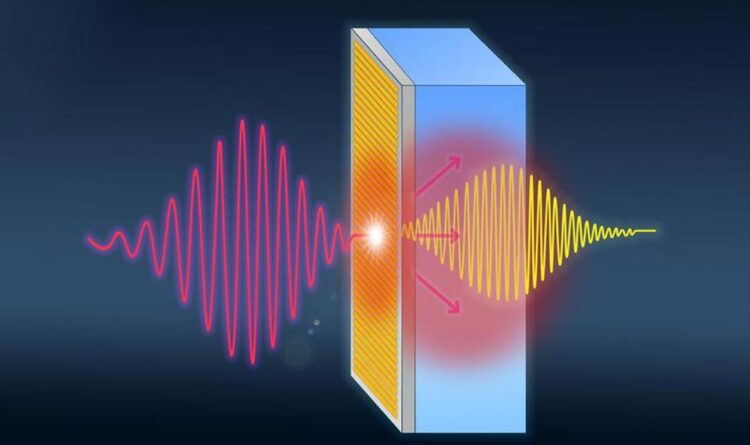Metamaterial for the terahertz age

Incident terahertz radiation (left) that is incident on a topological insulator metamaterial is efficiently upconverted to its third harmonic, thanks to strong nonlinearity and efficient electronic surface-to-bulk heat dissipation.
Credit by K. J. Tielrooij
Quantum materials enable next-generation photonics and mobile networks in the terahertz regime.
Terahertz light, radiation in the far-infrared part of the emission spectrum, is currently not fully exploited in technology, although it shows great potential for many applications in sensing, homeland security screening, and future (sixth generation) mobile networks. Indeed, this radiation is harmless due to its small photon energy, but it can penetrate many materials (such as skin, packaging, etc.). In the last decade, a number of research groups have focused their attention on identifying techniques and materials to efficiently generate THz electromagnetic waves: among them is the wonder material graphene, which, however, does not provide the desired results. In particular, the generated terahertz output power is limited.
Better performance has now been achieved by topological insulators (TIs) – quantum materials that behave as insulators in the bulk while exhibiting conductive properties on the surface—, according to a paper recently published in ‘Light: Science & Applications’. This study was carried out by members of the ICN2 Ultrafast Dynamics in Nanoscale Systems Group, led by Dr Klaas-Jan Tielrooij, and of the High-field THz Driven Phenomena Group at the Helmholtz-Zentrum Dresden-Rossendorf (HZDR, Germany), led by Dr Sergey Kovalev, in collaboration with researchers from the ICN2 Physics and Engineering of Nanodevices Group, headed by ICREA Prof. Sergio O. Valenzuela, from the School of Physics and Astronomy of the University of Manchester (UK), and the Physics Institute of the University of Würzburg (Germany). The experiments were performed at the TELBE THz facility in Dresden.
Earlier studies had shown that materials which host electrons with zero effective mass enable efficient generation of terahertz harmonics, including the aforementioned graphene and topological insulators. The phenomenon of harmonic generation occurs when photons of the same frequency and energy interact non-linearly with matter, leading to the emission of photons whose energy is a multiple of that of the incident ones. This can be exploited, for example, to upconvert electronically generated signals in the high GHz regime into signals in the THz regime.
Dr Tielrooij and colleagues investigated the behaviour of two topological insulators –the prototypical Bi2Se3 and Bi2Te3– in direct comparison with a reference graphene sample. They observed that, while the maximum power of the harmonics generated in graphene is limited by saturation effects (which arise at high incident powers), in these quantum materials it continued to increase with the incident fundamental power. The performed experiments revealed an improvement in generated output power by orders of magnitude over graphene, approaching the milliwatt regime.
This significant divergence in behaviour is due to the fact that topological insulators can rely on a highly efficient cooling mechanism, in which the massless charges on the surface dissipate their electronic heat to those in the rest of the thin film. In other words, bulk electrons lend a helping hand to the surface-state electrons by sinking electronic heat. The highest output power for the terahertz third-harmonic –i.e. radiation with three times the same energy– was achieved in a metamaterial that contained a topological insulator film together with a metallic grating –consisting of metal strips separated by gaps on the surface of the material.
“In this work we were able to demonstrate that the saturation effect occurring in graphene is much less present in topological insulators. This occurs thanks to a novel cooling mechanism between surface and bulk electrons of topological insulators,” explains Dr Klaas-Jan Tielrooij, first author of the paper. “These quantum metamaterials thus bring nonlinear terahertz photonics technology a big step closer.” Sergey Kovalev, last author of the paper, adds: “The obtained results furthermore offer interesting possibilities towards studying the quantum properties of these materials with prospects towards quantum technologies.”
Journal: Light Science & Applications
DOI: 10.1038/s41377-022-01008-y
Media Contact
All latest news from the category: Materials Sciences
Materials management deals with the research, development, manufacturing and processing of raw and industrial materials. Key aspects here are biological and medical issues, which play an increasingly important role in this field.
innovations-report offers in-depth articles related to the development and application of materials and the structure and properties of new materials.
Newest articles

Innovative 3D printed scaffolds offer new hope for bone healing
Researchers at the Institute for Bioengineering of Catalonia have developed novel 3D printed PLA-CaP scaffolds that promote blood vessel formation, ensuring better healing and regeneration of bone tissue. Bone is…

The surprising role of gut infection in Alzheimer’s disease
ASU- and Banner Alzheimer’s Institute-led study implicates link between a common virus and the disease, which travels from the gut to the brain and may be a target for antiviral…

Molecular gardening: New enzymes discovered for protein modification pruning
How deubiquitinases USP53 and USP54 cleave long polyubiquitin chains and how the former is linked to liver disease in children. Deubiquitinases (DUBs) are enzymes used by cells to trim protein…



